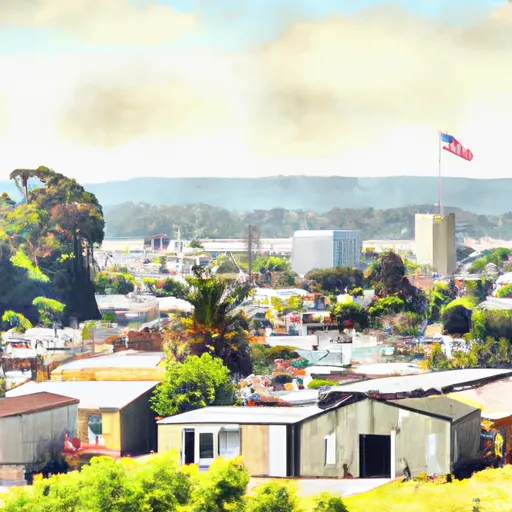-
 Snoflo Premium
Snoflo Premium
Get unlimited access to all our content
With no Ad interruptions! - Start Your Free Trial Login with existing account
Samoa
Eden Index
Climate
9.9
•
Recreation
4.1
•
Community
2.3
•
Safeguard
6.0/10

Samoa is a small coastal town located in Humboldt County, California. Its climate is characterized by mild, wet winters and cool, dry summers, typical of the Mediterranean climate zone. Winter temperatures range from 40-55°F (4-13°C), while summers average around 60-70°F (15-21°C). The region receives about 40 inches (101 cm) of annual rainfall, with the majority occurring during the winter months.
As for hydrology constituents, Samoa is situated near the mouth of the Samoa River, which flows into the Pacific Ocean. The river, along with nearby wetlands and marshes, provides critical habitat for various species of birds, fish, and wildlife.
Outdoor enthusiasts visiting Samoa can partake in a range of recreational activities. The region offers opportunities for hiking, biking, and birdwatching, with several nature trails and scenic routes to explore. The coastal location also opens up possibilities for water-based activities such as kayaking, fishing, and surfing. Samoa Beach, with its wide sandy shores, is a popular spot for beachcombing, picnicking, and enjoying the stunning sunsets.
Overall, Samoa, California offers a mild Mediterranean climate, diverse hydrology constituents, and a variety of outdoor recreation opportunities for visitors to enjoy.
What is the Eden Index?
The Snoflo Eden Index serves as a comprehensive rating system for regions, evaluating their desirability through a holistic assessment of climate health, outdoor recreation opportunities, and natural disaster risk, acknowledging the profound impact of these factors on livability and well-being.
Climate Health Indicator (CHI): 9.9
Samoa receives approximately
1041mm of rain per year,
with humidity levels near 72%
and air temperatures averaging around
12°C.
Samoa has a plant hardyness factor of
9, meaning
plants and agriculture in this region tend to thrive here all year round.
By considering the ideal temperature range, reliable water supplies, clean air, and stable seasonal rain or snowpacks, the Climate Health Indicator (CHI) underscores the significance of a healthy climate as the foundation for quality living.
A healthy climate is paramount for ensuring a high quality of life and livability in a region, fostering both physical well-being and environmental harmony. This can be characterized by ideal temperatures, reliable access to water supplies, clean air, and consistent seasonal rain or snowpacks.
Weather Forecast
Streamflow Conditions
Northern California Coastal
Area Rivers
Northern California Coastal
Snowpack Depths
Northern California Coastal
Reservoir Storage Capacity
Northern California Coastal
Groundwater Levels
Recreational Opportunity Index (ROI): 4.1
The Recreational Opportunity Index (ROI) recognizes the value of outdoor recreational options, such as parks, hiking trails, camping sites, and fishing spots, while acknowledging that climate plays a pivotal role in ensuring the comfort and consistency of these experiences.
Access to outdoor recreational opportunities, encompassing activities such as parks, hiking, camping, and fishing, is crucial for overall well-being, and the climate plays a pivotal role in enabling and enhancing these experiences, ensuring that individuals can engage in nature-based activities comfortably and consistently.
Camping Areas
| Campground | Campsites | Reservations | Toilets | Showers | Elevation |
|---|---|---|---|---|---|
| Clam Beach County Park | 18 | 20 ft | |||
| Samoa Boat Ramp County RV Park | 25 | 8 ft | |||
| Big Lagoon County Park | 25 | 10 ft | |||
| Patricks Point State Park | 124 | 212 ft | |||
| Redwood Acres Fairgrounds | None | 136 ft | |||
| Humboldt County Fairgrounds | 100 | 25 ft |
Nearby Ski Areas
Catastrophe Safeguard Index (CSI):
The Catastrophe Safeguard Index (CSI) recognizes that natural disaster risk, encompassing floods, fires, hurricanes, and tornadoes, can drastically affect safety and the overall appeal of an area.
The level of natural disaster risk in a region significantly affects safety and the overall livability, with climate change amplifying these risks by potentially increasing the frequency and intensity of events like floods, fires, hurricanes, and tornadoes, thereby posing substantial challenges to community resilience and well-being.
Community Resilience Indicator (CRI): 2.3
The Community Resilience Indicator (CRI) recognizes that education, healthcare, and socioeconomics are crucial to the well-being of a region. The CRI acknowledges the profound impact of these elements on residents' overall quality of life. By evaluating educational resources, healthcare accessibility, and economic inclusivity, the index captures the essential aspects that contribute to a thriving community, fostering resident satisfaction, equity, and social cohesion.

